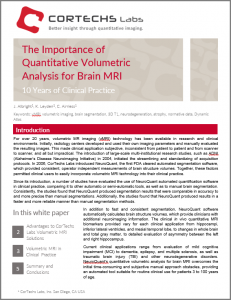 Volumetric brain imaging is a powerful tool for providing clinicians with clinical in vivo quantitative MRI biomarkers in their evaluation of many neurodegenerative conditions. Current clinical applications range from MCI, dementia (Alzheimer’s), MS, epilepsy to TBI and the list grows longer every day. Traditional methods of manual and semi-automatic brain structure segmentation is a very time-consuming and therefore, rarely used in most clinical environments. Advancements in automated volumetric MR imaging tools, such as NeuroQuant and LesionQuant, allow for the associated biomarkers to be easily incorporated into clinical practice.
Volumetric brain imaging is a powerful tool for providing clinicians with clinical in vivo quantitative MRI biomarkers in their evaluation of many neurodegenerative conditions. Current clinical applications range from MCI, dementia (Alzheimer’s), MS, epilepsy to TBI and the list grows longer every day. Traditional methods of manual and semi-automatic brain structure segmentation is a very time-consuming and therefore, rarely used in most clinical environments. Advancements in automated volumetric MR imaging tools, such as NeuroQuant and LesionQuant, allow for the associated biomarkers to be easily incorporated into clinical practice.
NeuroQuant software automatically segments and calculates brain structure volumes, delivering fast and consistent neuroimaging information. The clinical MRI biomarkers provided vary for each clinical application from hippocampi, inferior lateral ventricles, and mesial temporal lobe, to changes in the whole brain and total gray matter or detailed evaluation of asymmetry between the left and right hippocampus.
Since NeuroQuant’s introduction, several studies have evaluated the general use of automated volumetric brain imaging software in clinical practice, comparing it to other automatic or semi-automatic tools, as well as to manual segmentation. Consistently, the studies find that NeuroQuant produces segmentation results that are comparable to and better than manual segmentations. Additionally, the studies find that NeuroQuant provides results much faster and reliable than manual methods.
To learn more about the importance of using quantitative volumetric imaging for brain MRI in clinical practice, check out our latest Cortechs.ai white paper.
To see how you can use automated quantitative analysis to more objectively analyze your patients’ data, visit our website.
![]()
